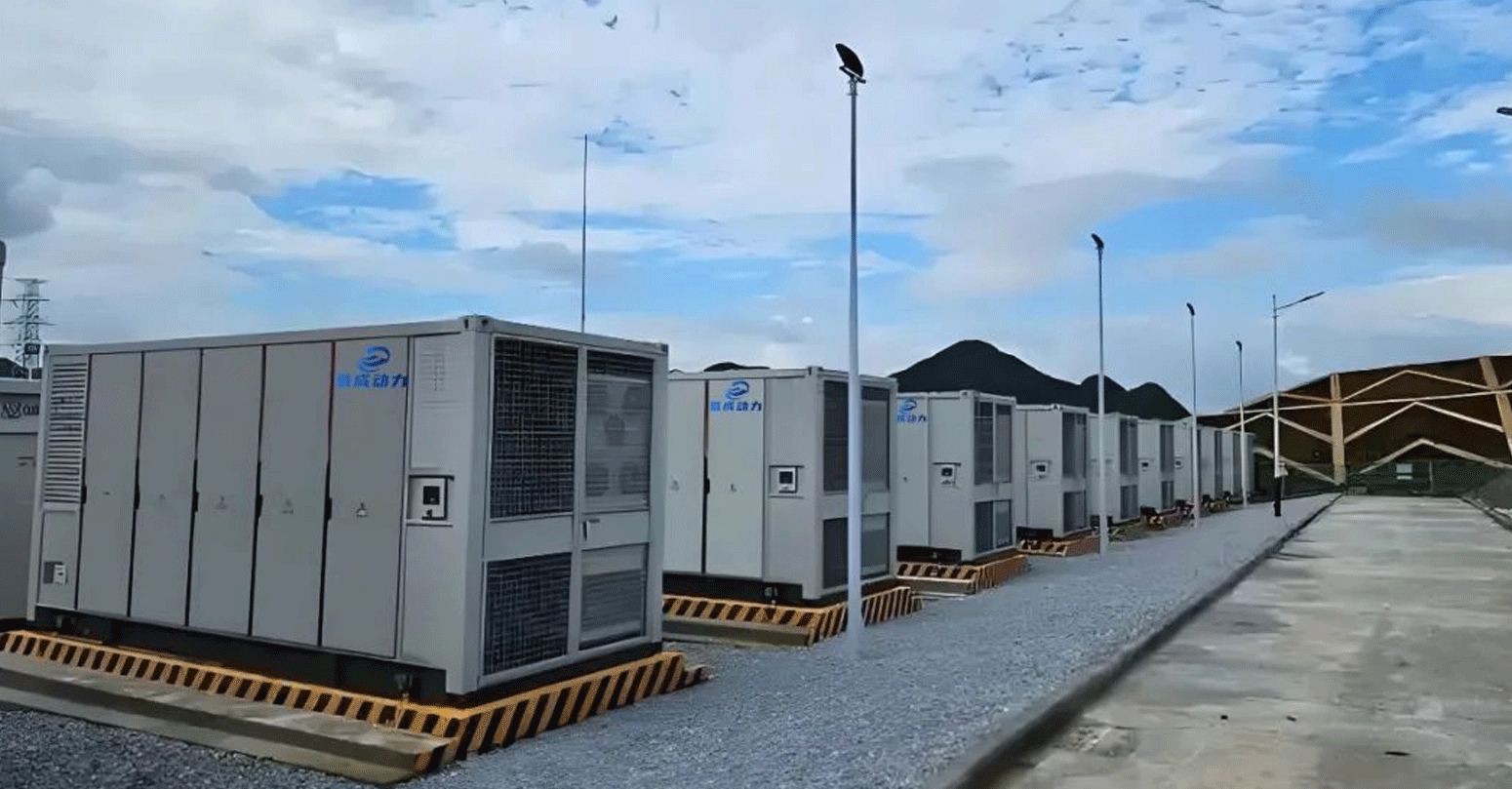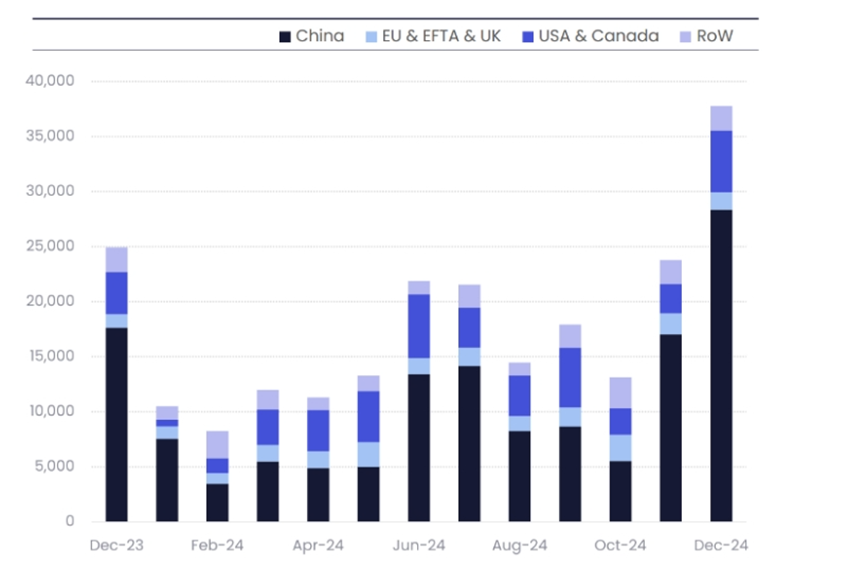In 2024, new energy storage continues to develop rapidly, with installed capacity exceeding 70 million kilowatts. By the end of 2024, the cumulative installed capacity of newly built energy storage projects nationwide reached 73.76 million kilowatts / 168 GWh, which is about 20 times that of the end of the 13th Five-Year Plan and represents an increase of over 130% compared to the end of 2023.
The press conference stated that the average energy storage duration of new energy storage is 2.3 hours, an increase of about 0.2 hours compared to the end of 2023. The operational level of new energy storage dispatch continues to improve. According to statistics from grid companies, the equivalent utilization hours of new energy storage in 2024 are approximately 1,000 hours, effectively promoting the development and consumption of renewable energy, ensuring peak supply, and safeguarding the safe and stable operation of the power system, thereby strongly supporting the construction of a new power system.

National Policies and News
01
National Energy Administration: By the end of 2024, the newly built and operational new energy storage capacity nationwide will reach 73.76 GW/168 GWh (January 23).
On January 23, the National Energy Administration held a press conference to introduce the development of new energy storage.
In 2024, "developing new energy storage" is included in the government work report for the first time. The recently promulgated "Energy Law of the People's Republic of China" stipulates the promotion of high-quality development of new energy storage and the role of various types of storage in regulating the power system.
It is reported that in 2024, new energy storage will maintain a rapid development trend, with installed capacity exceeding 70 million kilowatts.
By the end of 2024, the total installed capacity of new energy storage projects nationwide will reach 73.76 million kilowatts/168 million kilowatt-hours (73.76 GW/168 GWh),which is about 20 times that at the end of the 13th Five-Year Plan, an increase of over 130% compared to the end of 2023.
The press conference stated,
the average energy storage duration of new energy storage is 2.3 hours,an increase of about 0.2 hours compared to the end of 2023. The scheduling and utilization level of new energy storage continues to improve. According to statistics from grid companies,
the equivalent utilization hours of new energy storage in 2024 will be about 1,000 hours,which has effectively promoted the development and consumption of renewable energy, peak supply assurance, and ensured the safe and stable operation of the power system, strongly supporting the construction of a new power system.
From a regional perspective, the top five provinces in terms of cumulative installed capacity of new energy storage are: Inner Mongolia 10.23 million kilowatts/24.39 million kilowatt-hours, Xinjiang 8.57 million kilowatts/28.71 million kilowatt-hours, Shandong 7.17 million kilowatts/15.55 million kilowatt-hours, Jiangsu 5.62 million kilowatts/11.95 million kilowatt-hours, Ningxia 4.43 million kilowatts/8.82 million kilowatt-hours. Ten provinces including Hebei, Zhejiang, Gansu, Guangdong, Hunan, Guangxi, Henan, Anhui, Hubei, and Guizhou have installed capacities exceeding 2 million kilowatts. The installed capacity of new energy storage in North China accounts for 30.1% of the national total, Northwest 25.4%, East China 16.9%, Central China 14.7%, South 12.4%, and Northeast 0.5%.
In terms of single station installed capacity, new energy storage stations are gradually showing a trend of centralization and large-scale development. By the end of 2024, projects with an installed capacity of 100,000 kilowatts and above will account for 62.3%, an increase of about 10 percentage points compared to 2023, while projects with an installed capacity of 10,000 to 100,000 kilowatts will account for 32.8%, and projects with an installed capacity of less than 10,000 kilowatts will account for 4.9%.
In terms of energy storage duration, projects with new energy storage stations of 4 hours and above are gradually increasing, accounting for 15.4%, an increase of about 3 percentage points compared to the end of 2023, while projects with 2 to 4 hours account for 71.2%, and projects with less than 2 hours account for 13.4%.
02The "Green Technology Promotion Catalog (2024 Edition)" was released (January 20).
1. Technology Name: Key Technologies for Constructing and Demonstrating Pure Renewable Energy Power Systems Based on Networked Energy Storage.
2. Technology Name: 3.35 MWh Liquid-Cooled Lithium-Ion Battery Energy Storage Prefabricated Cabin.
3. Technology Name: Advanced Compressed Air Energy Storage Technology at the Megawatt Level.
4. Technology Name: Zinc-Iron Flow Battery.
5. Technology Name: Flexible DC Microgrid Direct Access Technology.
6. Technology Name: Photovoltaic and Storage Direct Flexible Park/Community Microgrid Technology.
7. Technology Name: Large-Scale Molten Salt Energy Storage Technology.
8. Technology Name: Clean Recycling Technology for Valuable Components of Waste Power Batteries.
9. Technology Name: Technology and Application for the Sequential Utilization of Retired Power Batteries.
10. Technology Name: Comprehensive Recycling Technology for Waste Lithium-Ion Batteries.
11. Technology Name: Integrated Production Process for Lithium Battery Ternary Materials.
01
The Jilin Provincial Development and Reform Commission issued the "Notice on Further Optimizing the Time-of-Use Electricity Price Policy" (January 16).
On January 16, the Jilin Provincial Development and Reform Commission issued the "Notice on Further Optimizing the Time-of-Use Electricity Price Policy." It proposes that,
commercial and industrial users are encouraged to reduce peak electricity load and increase off-peak electricity consumption by configuring energy storage and carrying out comprehensive energy utilization, thereby reducing electricity costs.
At the same time, the electricity prices during peak and off-peak periods will fluctuate by 55% up and down based on the regular period price, and the peak electricity price for commercial and industrial users will no longer be executed according to fixed months and periods, but will be adjusted to a flexible start mechanism.
The peak and valley periods have been adjusted, with the midday off-peak period increased from 1 hour to 3 hours, the peak period reduced to 7 hours, and the peak electricity price canceled. The details are as follows:
Peak period: 8:00-10:00, 16:00-21:00 (total of 7 hours).
Regular period: 5:00-8:00, 10:00-11:00, 14:00-16:00, 21:00-23:00 (total of 8 hours).
Off-peak period: 00:00-5:00, 11:00-14:00, 23:00-24:00 (total of 9 hours).
This can fully utilize the signal effect of time-of-use electricity prices, guiding electricity users to reduce peak and fill valleys, improving the power supply and demand situation, promoting the development of renewable energy, and achieving linkage between user-side and generation-side time-of-use electricity prices.
02 The Hebei North Power Trading Center issued the "Implementation Rules for Independent Energy Storage Participation in Medium and Long-Term Trading in the Hebei North Power Grid (Trial)".
Recently, the Hebei North Power Trading Center issued the "Implementation Rules for Independent Energy Storage Participation in Medium and Long-Term Trading in the Hebei North Power Grid (Trial)." The document states: Independent energy storage can start capacity leasing after being built and connected to the grid and completing market member registration, with a maximum rental period tentatively set at 15 years.
The document clarifies that before the operation of the electricity spot market, relevant regulations for medium and long-term energy trading and capacity leasing for independent energy storage will be implemented.
Capacity leasing transactions will be conducted monthly as needed. The minimum leasing period for renewable energy companies renting energy storage capacity should last until the end of the current year. The annual leasing capacity and price will remain consistent.
If new energy enterprises that need to build energy storage fail to lease the required energy storage capacity in full,
they shall pay the difference in capacity leasing fees at 1.2 times the average leasing price of the entire network for that month.
The registration conditions for independent energy storage require connection to the public grid, with a scale of no less than 10MW/2 hours,and the connected system equipment (devices) must meet the technical requirements for safe and stable operation of the grid and scheduling management requirements, with qualified inspection reports;
obtain safety evaluation reports and fire acceptance reports.
01
In 2024, the global energy storage system deployment scale is expected to grow by 53% year-on-year.
Recently, an article by Iola Hughes, research director at market intelligence firm Rho Motion, pointed out that the scale of battery energy storage systems deployed worldwide is expected to grow by more than 50% in 2024, with grid-scale battery energy storage systems being the main driver of this growth.
Specifically, the global deployed energy storage system capacity is expected to reach 205GWh in 2024, a year-on-year increase of 53%, exceeding market expectations. The grid-scale energy storage market has once again become the growth engine, with global deployed energy storage capacity exceeding 160GWh.
Globally, the grid-scale energy storage market has grown from 96GWh to 160GWh, a year-on-year increase of 68%. This growth is mainly due to increased market demand and record declines in battery and system prices. China dominates this market, with the scale of deployed battery energy storage systems accounting for 67% of the global total.
In 2024, there will be 17 energy storage projects with a capacity of over 1GWh put into operation globally, of which 11 are located in China, 5 in the United States, and 1 in Saudi Arabia. In contrast, only 4 energy storage projects with a capacity exceeding 1GWh were put into operation globally in 2023. The scale of large energy storage projects under construction has significantly increased worldwide, with 140 projects of over 1GWh planned to be operational by 2025/2026, of which 30 projects have a storage capacity exceeding 2GWh.
At the same time, the average duration of deployed energy storage projects worldwide is also increasing, especially in Europe, where the growth is particularly significant, exceeding 2 hours for the first time (compared to only 1.4 hours in 2023). In 2024, the average duration of energy storage projects deployed in the United States and Canada is over 3 hours. The system duration matches profitability, as reflected in the two major energy storage markets in the United States: the average duration of energy storage projects deployed in Texas is 1.7 hours, while in California it is close to 4 hours.
02 Brazil is paving the way for the development of large energy storage systems.
Northeast Brazil concentrates more than 90% of the country's wind power installed capacity, but due to a lack of energy storage technology support, the system utilization efficiency is limited. According to ANEEL data, by 2024, the economic losses caused by power restrictions could reach 1 billion reais. The addition of large energy storage systems will give the grid greater regulation capabilities.
Disclaimer:
We respect originality and value sharing. The images and texts are sourced from the internet, and the copyright belongs to the original authors. If there are any issues regarding the content/copyright of the works, please contact us for removal.









